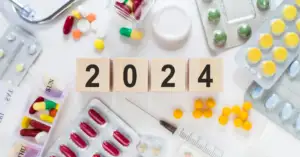The People’s Republic of China is a huge pharmaceutical market and big pharma companies have been trying to get into the Chinese market for past few years. Recognising the need for new drugs for the people of China with an opportunity to develop indigenous industry, Chinese government over the years have made several policy changes to accelerate research and development in the pharmaceutical industry as well as making sure that the new medicine from the western world is available in the country. The entire Drug Regulatory system is revamped to fast-track clinical development of the new chemical entities and boost clinical trials in the country.
We present a thorough description of the regulatory body, preclinical research, clinical trials, NMPA evaluation, and post-market surveillance in this blog article on China’s drug approval procedure.
- China’s Drug Regulatory Agency: The approval process for synthetic drugs in China is overseen by the China National Medical Products Administration (NMPA), formerly known as the China Food and Drug Administration (CFDA) which is the regulatory authority responsible for evaluating and approving pharmaceutical products in China. The approval process for biological drugs in China is similar to that of synthetic drugs but has additional considerations due to the complexity of biological molecules. Prior to being promoted and sold in China, new drugs, medical devices, and other medical items must be reviewed and approved by NMPA. In order to keep an eye on the security and calibre of medical items that are already on the market, NMPA regularly conducts inspections and post-market monitoring. In order to share knowledge and best practices, NMPA works with other regulatory bodies and organisations both domestically and abroad, particularly in the area of international drug and medical device development. The length of the NMPA review process varies, but a new drug is normally approved in China within 1-2 years.
- Preclinical Studies: A novel medication must first go through preclinical research to assess its toxicity profile, safety and effectiveness before it can be tried on humans. Preclinical research in China must follow the requirements of Good Laboratory Practice (GLP). These investigations, which comprise toxicological and pharmacological testing, are necessary for China’s new medication application procedure. Examining the drug’s mode of action and impact on biological systems is part of pharmacological testing. In toxicological testing, the possible toxicity of the medicine to living things is assessed. The package for the new drug application that was submitted to the NMPA contains the findings of these research.
- Clinical Trials: The purpose of clinical trials is to assess a new drug’s effectiveness and safety in human subjects. There are three stages to the clinical trial process in China.
- A small number of healthy volunteers participate in Phase 1 trials to assess the drug’s safety and dosage.
- Phase 2 involves a small sample size of patients to assess the safety and effectiveness of the medication.
- In Phase 3, a larger sample size of patients is enrolled to verify the medication’s effectiveness and track any negative side effects.
The new drug application (NDA) package must include the clinical trial data that has been submitted to the NMPA. The material must include comprehensive details about the trial design, patient demographics, adverse events, and efficacy outcomes, all in accordance with Good Clinical Practice (GCP) principles.
- Review of NMPA: One important stage in China’s drug licensing procedure is the NMPA review procedure. There are three steps in the procedure, and each one is crucial to guaranteeing the effectiveness and safety of medications supplied in China.
- Technical Review: The NMPA evaluation procedure begins with the technical review. They assess the new drug application package that the drug manufacturer submitted during this procedure to make sure it satisfies all legal and regulatory standards. This can involve verifying that the drug’s production process complies with Good production Practice (GMP) rules and that the preclinical and clinical trial data fulfill the necessary criteria. The NMPA will go on to the next review step if the application package satisfies all legal requirements. The NMPA will ask the medicine producer for more details or an explanation if there are any problems with the application package.
- Onsite Inspection: To verify adherence to GMP regulations, the NMPA inspects the drug manufacturing plant throughout this phase. A study of the documentation methods, quality control systems, and production process are all part of the inspection. To verify adherence to Good Clinical Practice (GCP) principles, the NMPA may also conduct site inspections of the clinical trial locations. If the onsite inspection finds any problems, the NMPA will ask the medication maker to take corrective action. Before the NMPA can move forward to the last phase of the review procedure, the medication manufacturer must fix any problems found during the onsite inspection.
- Expert Review: After then, the information included in the new medication application package is assessed by a group of specialists. Experts in clinical medicine, toxicology, pharmacology, statistics, and drug regulatory affairs are on the panel. The drug’s quality, safety, and effectiveness are assessed, along with the production process, by the expert review. Before deciding whether to approve the medication, the experts could ask the drug’s producer for more details or an explanation. Before the medication is authorised for sale in China, the producer must fix any problems found by the expert evaluation.
- Post-Market Surveillance: The NMPA mandates post-market surveillance to keep an eye on a medication’s effectiveness and safety after it is authorised for sale in China. The manufacturer of the medication is expected to monitor adverse events continuously and provide safety data on a regular basis. To verify adherence to GMP regulations, the NMPA may also carry out inspections of the medication production plant.
The applicant must pay a charge in accordance with the applicable regulations. As part of the drug registration procedure, the National Medical Products Administration (NMPA) levies drug registration fees to assess and approve clinical trials. The fees for several drug categories are listed below.
- New drugs made in China
- New drugs made outside China
- Generic drugs made in China
- Generic drugs made outside China
The licensing processes for synthetic drug products and biologic drugs in China are comparable, yet there are significant variances due to biologics’ unique properties. Biologics are evaluated more thoroughly because of their complicated structure, production procedures, potential immunogenicity, and unique properties. Synthetic drugs are usually subject to a conventional national approval process. In China, biologics can go through both centralised and national approval processes. China is not an ICH country but has its own national regulations and requirements that are based on ICH and other guidelines from the western world.





